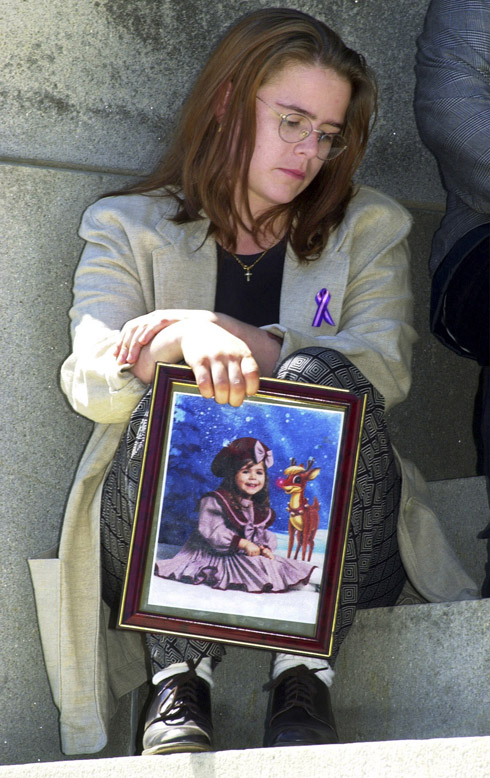PORTLAND — Five-year-old Logan Marr’s death at the hands of her foster mother a decade ago was a tragedy that highlighted the vast shortcomings of Maine’s child welfare system.
She was a little girl who loved grape soda, butterflies and the PBS cartoon “Arthur,” and experts say Logan’s death served as a catalyst for widespread changes that transformed Maine’s foster-care system into one of the best in the nation.
Logan died Jan. 31, 2001 – 10 years ago Monday – after her foster mother, Sally Schofield, confined her to a high chair in the basement of her Chelsea home and wrapped layers of duct tape around her head, mouth and chest. Logan suffocated, and Schofield is serving a 17-year sentence following her conviction for manslaughter.
In the years since, the number of children in foster care in Maine has been cut in half. Those that are in the foster-care system are three times more likely to be placed with family members rather than with strangers. Case workers now visit foster children at least once a month, rather than the three-month standard back then.
Maine’s child welfare system has been held up as a national model by the Annie E. Casey Foundation, a private organization in Baltimore that works on child welfare issues. Harvard’s Kennedy School of Government named it a finalist for its prestigious Innovations in American Government awards in 2009.
Logan’s death was the driving force behind the improvements, said Jim Beougher, director of the Office of Child and Family Services at the Maine Department of Health and Human Services. The case helped awaken the department to respond to abuse and neglect cases more quickly and see foster children in their homes more often.
“I think Logan’s tragedy crystalized that for us,” Beougher said.
Logan Marr wasn’t breathing when police were called to Sally Schofield’s home on Jan. 31, 2001. She was later pronounced dead at an Augusta hospital.
Schofield, who was a former foster care case worker herself, was serving as a foster parent for Logan and her half-sister Bailey, a toddler at the time. The girls had been taken from their mother by the state.
Schofield told police Logan struck her head after falling from a highchair during a timeout. But investigators were suspicious because of inconsistencies in her story and because Logan’s eyes showed signs of hemorrhages consistent with suffocation. An autopsy later determined that the girl died from asphyxiation.
At the trial the following year, prosecutors demonstrated how Schofield used 42 feet of duct tape to cover Logan’s mouth, strap her jaw shut and bind her to a highchair in a cluttered basement after the girl awoke from an afternoon nap screaming. Schofield was acquitted of murder, but a judge found her guilty of manslaughter.
The case shined a spotlight on Maine’s troubled foster care system, which came under fire after Logan’s death.
The PBS public affairs show Frontline ran a three-part series, “Failure to Protect,” that focused on the Logan Marr case and Maine’s child-welfare system. The series raised questions on why the state removed Logan from her mother’s custody in the first place, and whether it failed to heed warning signs that she was in trouble under Schofield’s care.
A child’s death always spurs changes in child welfare systems, said Richard Wexler, executive director of the National Coalition for Child Protection Reform in Alexandria, Va. Often those changes are for the worse, he said, but the reforms in Maine – to the state’s credit – were good.
Since 2001, the number of children taken from their homes has dropped by 30 percent, and the number of children in foster care on any given day has been cut in half, he said.
At the same time, the proportion of foster children placed in group homes and other institutions has dropped from about 28 percent to 10 percent, making Maine one of the best in the nation at avoiding placing foster children in so-called “congregate care” settings, Wexler said.
It’s been said that reforming a child welfare system is “like fixing a bicycle while you’re riding it,” Wexler said.
“Nobody’s reached the mountaintop yet, but Maine is halfway to two-thirds there,” Wexler said. “Most of the rest of the country is just getting off the ground.”
Tracy Feild, of the Annie E. Casey Foundation, said child welfare managers, case workers and advocates, as well as some legislators, from Virginia, Louisiana, Maryland and Indiana have visited Maine in recent years to get a firsthand look at its child welfare system.
“Maine was not on the map as being a leader in the past,” Feild said. “Now they’re viewed as having really good outcomes.”
Copy the Story LinkSend questions/comments to the editors.



Success. Please wait for the page to reload. If the page does not reload within 5 seconds, please refresh the page.
Enter your email and password to access comments.
Hi, to comment on stories you must . This profile is in addition to your subscription and website login.
Already have a commenting profile? .
Invalid username/password.
Please check your email to confirm and complete your registration.
Only subscribers are eligible to post comments. Please subscribe or login first for digital access. Here’s why.
Use the form below to reset your password. When you've submitted your account email, we will send an email with a reset code.